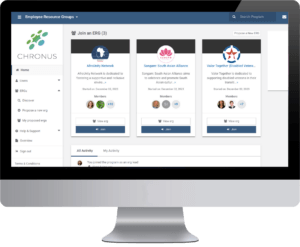Employee resource groups (ERGs) have been a part of corporate life since the 1960s, but they are growing in popularity. In fact that number of ERGs at companies rose more than 20% between 2021 and 2022, according to The Rise Journey. As employees look for support within their organizations and companies aim to foster engagement, ERGs create a sense of belonging and advance diversity, equity and inclusion (DEI) goals.
With all this, it’s becoming more and more apparent how valuable these internal communities of employees really are in today’s workplace. This article explores the benefits of ERGs, what effective employee resource groups are, and how they benefit companies, while also offering ERG examples and best practices.

What are Employee Resource Groups?
Employee resource groups are networks for employees who have common identities, religious affiliations or interests, offering them an opportunity to come together to build community at work. ERGs tend to be grassroots, formed by volunteer employees within a company, but they are often officially sponsored and supported by the organization.
These groups can also be called business resource groups (BRGs), people groups, employee-led groups or affinity groups. Employee resource groups are often centered around underrepresented groups such as women, BIPOC, LGBTQIA, workers with disabilities and beyond. However, ERGs have grown to include groups focusing on many other areas, such as parenting, caregiving, physical and mental health and more.
At a time when companies are struggling with challenges such as quiet quitting, high turnover, and disconnection due to remote work, affinity groups are an effective way to increase employee morale, engagement and a sense of community. Fortune 500 companies recognize these benefits—90 percent of them have employee resource groups in place to support employees.
Types of Employee-Led Groups
Employee-led groups are formed to create a sense of community among employees with shared interests or experiences. They offer support, share resources, and address workplace challenges. These groups also promote inclusion and diversity, improving employee satisfaction and retention.
- Women: Forming a women’s ERG supports gender diversity and equality in the workplace. providing a platform for women to network, mentor each other and address gender-specific challenges.
- Culture or Ethnicity: Culture or ethnicity ERGs celebrate diversity, promote inclusion and help address the unique needs and challenges faced by employees from different cultural backgrounds.
- Gender Identity or Sexual Orientation: ERGs for gender identity or sexual orientation create a safe and supportive environment for LGBTQ+ employees, promoting acceptance and understanding within the company while allowing employees to self identify as they choose.
- Mental Health: Mental health ERGs focus on creating awareness, reducing stigma and providing support and resources for employees dealing with mental health issues.
- Caregivers, Working Parents, Single Parents: These ERGs provide support and a network for employees balancing work with caregiving responsibilities, offering support, resources and advocating for family-friendly workplace policies.
- Veterans: Veterans’ ERGs support military veterans in the workforce by addressing their unique needs, promoting career development, and facilitating a sense of community among veteran employees.
- Age-Based: Age-based ERGs, such as those for young professionals, provide networking opportunities, career development resources and support for employees at similar stages in their careers.
What Does an Employee Resource Group Do?
The purpose of an ERG is to offer members support, community and a psychologically safe space. That can come in many forms. Typically, they have regular gatherings that can include opportunities to socialize and build relationships as well as discuss common challenges and solutions. But the activities and initiatives they offer are as unique as their members and based on their needs.
Benefits of Employee Resource Groups
ERGs provide valuable resources for employees, but they offer clear advantages for employers as well. Often the goals of ERGs are focused on:
- Promoting DEI: ERGs strive to create a more inclusive workplace by representing the interests and needs of diverse employee groups. They work to ensure that all voices are heard and valued, helping to achieve diversity and build an inclusive culture.
- Enhancing Employee Engagement: By providing employee community building and belonging, ERGs enhance employee engagement. They offer opportunities for employees to connect, share experiences, and support one another, leading to increased job satisfaction and commitment to the organization.
- Supporting Career Development: ERGs often provide mentorship, networking, and professional development opportunities. They aim to help members grow their skills, advance their careers, build leadership connection and gain visibility within the organization.
- Driving Cultural Change: ERGs play a crucial role in raising awareness about diversity, equity, and inclusion issues. They advocate for policies and practices that promote workplace diversity, fairness and equality, contributing to a more equitable workplace culture.
- Facilitating Communication and Collaboration: ERGs serve as a bridge between employees and management, facilitating open communication about concerns, needs, and suggestions. They help create a collaborative environment where feedback is encouraged and acted upon.
When employees can turn to an employee resource group for a strong community and meaningful relationships at work, the freedom to be themselves and trusted help when they need it, the results for companies include:
- Improved employee retention and job satisfaction
- Increased productivity and innovation
- Enhanced recruitment efforts
- Strengthened DEI and company culture
Employee Resource Group Best Practices
In order to realize the full benefits of ERGs, it’s important to set your organization up for success. Follow these employee resource group best practices.
1. Establish Clear Goals and Objectives
It’s difficult to accomplish your goals if they’re ambiguous. For each employee resource group, the mission and objectives of the group should be clearly spelled out so everyone—from company leaders to ERG members—knows exactly what the group wants to accomplish. Making sure each ERG has a goal or set of goals to start will help drive productivity and action around these goals for each group, while maintaining consistent standards across the ERGs in your organization.
2. Encourage Leadership Support and Participation
Leadership support is key for a successful employee-led group to ensure an effective flow of communication and resources. At Airbnb, for example, each of its employee resource groups is led by employees but sponsored by a member of the company’s executive team. For ERGs to have the right level of support (budget and resources), it’s important to get senior leadership involved as participants, executive sponsorship and/or participants. This showcases that employee resource groups are important to the company, and keeps people informed of what’s happening in ERGs and why they are a part of a welcoming community.
3. Create an Open and Inclusive Environment
While ERGs are often formed around common identities or interest, it should be clear that anyone is welcome to participate in them. This can be an effective way to educate and develop allies. For their part, allies need to recognize that their role is to support members according to their needs. How allies can support ERGs might look differently for each ERG. It’s important the the ERG Leaders decide what allyship will look like for their group and clearly communicate this to the rest of the employee population. Clear expectations can enable more people to get involved while retaining boundaries for the members of the employee-led group.
4. Develop a Structured Communication and Feedback Process
Communication is crucial to an ERG’s effectiveness. It can be helpful to have a set process for feedback and communication to create clear channels and transparency. These processes can apply to feedback between members of the group and employee-led group leaders, as well as between ERG Leaders, Chapter Leaders and organizational leadership. Knowing how to communicate and through which mediums to communicate can help keep things running smoothly for each employee resource group.
5. Ensure Accountability and Measurements of Success
An employee resource group’s goals should be SMART—specific, measurable, achievable, realistic, and time-bound. When you define the goals, you should also determine measures of success and who will be accountable for reporting the progress. Establishing this at the start will make for smoother sailing as the ERG evolves. Don’t overwhelm yourself at the beginning. Select one to two metrics that showcase participation and impact. As the ERG evolves, you might find new metrics to measure success. Don’t be afraid to adjust them as you go along to focus on the things that will serve you best in connection the ERG to organizational impact and participant outcomes. As ERGs evolve in an organization, it could be valuable to include participation reporting within performance reviews and year-end meetings to better understand how ERG members are performing and growing at the company.
Successful Employee Resource Groups Examples
ERGs can be found at a wide variety of organizations. Here are some examples of high-profile, successful groups.
- Google Women Techmakers Group – The motto of Google’s Women Techmakers program is “We’re building a world where all women can thrive in tech.” The group provides visibility, community and resources for women in technology. Members have access to curated resources and events, as well as information and tools from Google, its partners and the global tech ecosystem.
- Airbnb’s Black@ Employee Resource Group – Black@ is the employee resource group for Black employees and allies at Airbnb. In 2022, the group released an ERG Manual designed to help increase the impact of Black employee resource groups in the tech community. The manual is designed for people considering starting an employee resource group at their company, as well as members of existing Black ERGs.
- Microsoft Disability Employee Resource Group – The Microsoft Disability ERG drives internal visibility and collaborates with product teams to design, develop and build accessible, inclusive products. The Microsoft Disability Scholarship seeks to empower students with disabilities to achieve more through access to education leading to a career in technology.
- Warriors at Amazon Employee Resource Group – Warriors at Amazon includes current and former active military personnel, their families and the Amazon employees who support them. This group provides members with a professional network, organizes community outreach programs and assists veterans during their transition into civilian life within Amazon.
Challenges & Solutions for Effective Employee Resource Groups
Affinity groups offer many rewards, but establishing them can also pose challenges. Some common roadblocks to watch out for include:
- Overcoming resistance and skepticism from leadership or colleagues
- Ensuring representation and inclusivity within an ERG
- Addressing potential conflicts or tensions within employee resource groups
Careful planning and good communication can go a long way toward solving many of these issues—hopefully before they begin. Before they start operating, employee resource groups should have strong leadership backing, clear goals and protocols for inclusion and representation and processes for feedback and conflict resolution. Additionally, affinity groups require individuals to step up and serve as ERG leaders, ensuring inclusivity and excellence for all participating employees.
Providing the resources and support needed for an ERG to thrive is another challenge that can be addressed when the ERG is created. You need to be aware of what the ERG will need in terms of funding, physical and human resources, mentoring and development structures and more—and make a clear commitment to provide the support needed for success.
Enhance Your Employee Resource Groups with Chronus Software
Employee resource groups are on the rise for good cause. They provide employees—especially those populations that traditionally have had greater challenges in the workplace—with a community where they can be themselves, build relationships, and receive support. For companies, employee-led groups offer an opportunity to promote DEI and increase employee engagement. The number of ERGs will only continue to grow as organizations and employees recognize their value.
Chronus Connection Community software helps companies to streamline their Employee Resource Group offerings while driving engagement and connection with:
- Streamlined Management – Community software provides a centralized platform for managing various aspects of ERGs, including membership data, events, and communication. This centralization streamlines administrative tasks, making it easier for leaders to oversee and coordinate ERG activities.
- Robust Reporting – Employee community software centralizes data related to ERG programs, including membership information, event attendance, and engagement metrics. This makes aggregating data from various sources easier, providing a comprehensive view of ERG activities and making reporting on ERG impact to stakeholders easier.
- Career/Leadership Development – Community software often includes features that support professional development initiatives. This may involve tools for mentorship programs with Artificial Intelligence, skill-building workshops, and access to resources that contribute to the personal and professional growth of ERG members.
These features empower organizations to measure the success of employee-led groups, identify areas for improvement, and demonstrate the impact of these programs on the overall organizational strategy.





